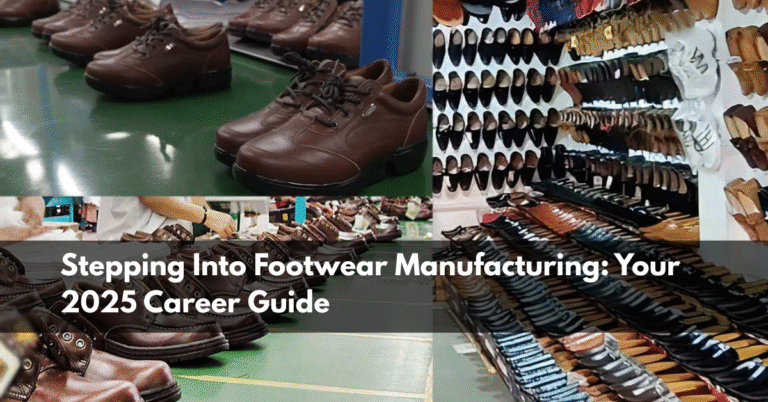Introduction – Why 2025 Is the Perfect Time to Join
The footwear manufacturing industry in 2025 is full of momentum and opportunity. From trendy fast-fashion sneakers to premium handcrafted leather shoes, demand is booming both in domestic and global markets. Factories are scaling up, investing in automated assembly lines, precision machinery, and sustainable materials. This growth has created openings across multiple roles—whether in stitching, cutting, quality control, packing, or logistics, there’s a place for almost every skill set. Many entry-level positions require minimal education, with most companies offering thorough on-the-job training to bridge technical gaps. Pay varies depending on skill and experience, but stable wages, predictable shifts, and performance bonuses are common. For those looking for a hands-on, skill-based career with a clear growth path, 2025 is the year to step into the footwear manufacturing sector.
1. The Current Footwear Manufacturing Landscape
Modern footwear factories are more advanced and versatile than ever:
-
A variety of products, from athletic wear to protective work boots.
-
Manufacturing hubs located near ports and cities, with many shifting to cost-effective zones.
-
Strong export demand driving investments in technical skills and advanced quality systems.
-
Automation blending with craftsmanship—think sewing robots, laser cutters, and digital mold systems.
-
Opportunities for both manual craftsmanship and technology-driven efficiency.
2. Common Roles & Responsibilities
a) Stitching and Sewing Operators
-
Sew shoe panels into uppers using industrial sewing machines.
-
Require accuracy, steady hands, and machine-handling skills.
b) Cutting Technicians
-
Cut leather or synthetic materials manually or with automated tools.
-
Match patterns, reduce waste, and maintain cutting tools.
c) Assembly & Lasting Assistants
-
Shape uppers over shoe molds (lasts) and align soles.
-
Ensure precision in fitting and alignment.
d) Quality Inspectors
-
Detect defects such as poor stitching or misalignment.
-
Maintain inspection records and manage rework batches.
e) Heat Press & Sole Bonding Operators
-
Use heat and pressure to attach midsoles and outsoles.
-
Monitor temperature and pressure settings for strong adhesion.
f) Packing & Carton Staff
-
Prepare shoes for shipping with accurate labeling and size indexing.
g) Logistics & Inventory Handlers
-
Track stock levels, prepare dispatch orders, and operate warehouse equipment.
3. Who Can Join?
-
Education: Many roles accept candidates with an 8th–10th grade pass; technical jobs may prefer 12th pass or vocational certifications.
-
Experience: Freshers are welcome for helper positions; technical roles may require prior experience.
-
Physical Requirements: Good eyesight, dexterity, and stamina for long hours on your feet.
4. Skills That Help You Grow
-
Attention to Detail – Spot small flaws before they leave the factory.
-
Machine Handling – Learn basic maintenance and troubleshooting.
-
Manual Precision – Keep stitching and cutting consistent.
-
Time Management – Hit production targets efficiently.
-
Teamwork – Work smoothly with colleagues across departments.
5. Training & Onboarding
-
On-the-job Training – Live demonstrations and practice sessions.
-
Mentorship – Pairing with experienced staff for 2–3 weeks.
-
Technical Orientation – Machine safety and maintenance basics.
-
Quality Workshops – Learning defect categories and product grading.
6. Pay Scales in 2025
-
Helpers & Packers: ₹12,000–₹18,000/month
-
Machine Operators & Stitchers: ₹17,000–₹25,000/month
-
Technicians & Inspectors: ₹20,000–₹30,000/month
-
Supervisors: ₹25,000–₹40,000/month
-
Additional pay often comes through attendance bonuses, shift allowances, and production incentives.
7. Working Conditions
-
Clean, well-lit factory floors with clearly marked zones for stitching, assembly, inspection, and packing.
-
Typically two 8-hour shifts per day.
-
Emphasis on uniforms, safety gear, and team coordination.
8. How to Apply & Get Noticed
-
Prepare a simple resume highlighting education and manual skills.
-
Attend walk-in interviews or approach local job agencies.
-
Be ready for practical skill demonstrations.
-
Show up neat, punctual, and willing to work shifts.
9. Career Growth Pathways
-
Operator → Senior Operator → Supervisor
-
Inspector → QC Coordinator → Quality Manager
-
Logistics Helper → Inventory Controller → Planner
-
Technician → Maintenance Engineer → Maintenance Lead
High performers often move up within 2–3 years.
10. Common Challenges & Solutions
-
Repetitive Work – Rotate stations to reduce fatigue.
-
Speed vs. Quality – Practice focus and take micro-breaks.
-
Machine Downtime – Learn basic troubleshooting.
-
Overtime Strain – Maintain good posture and hydration.
11. How to Stand Out
-
Maintain perfect attendance.
-
Keep your workstation organized.
-
Volunteer for cross-training.
-
Suggest process improvements.
12. Key Hiring Locations in 2025
-
Northeast & East: Export-heavy sneaker units.
-
South: Leather footwear clusters in Tamil Nadu & Karnataka.
-
Northwest: Safety boot manufacturing hubs.
-
Central India: Medium-scale units for urban supply.
13. The Future of Footwear Jobs
-
Automation Integration: Cobots and smart machinery.
-
Sustainable Materials: Demand for eco-leather handling skills.
-
3D Printing: Roles in prototype checks.
-
Digital Production Tools: Familiarity with software dashboards.
Conclusion
Footwear manufacturing in 2025 offers accessible entry points, practical skill-building, and clear career growth opportunities. Whether you start as a stitcher, inspector, technician, or packer, the industry promises stability and advancement. With trends like automation, sustainability, and global demand shaping the future, now is the time to lace up and step into a career that can take you far.

